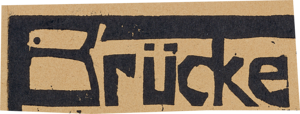Archive
1910: Brücke: Art and Life
28. August 2022
1910 was one of the most formative years of the Brücke artists’ group and their artistic zenith. Established five years earlier by architecture students Erich Heckel, Ernst Ludwig Kirchner, and Karl Schmidt-Rottluff in Dresden, the group developed its shared style in that year. In the studio or out in nature, these artists worked with an intensive collaborative ethos, mutually influencing each other along the way. Quick brushstrokes, bold colours, and an unabashed vigour marked their work during this period. Speaking of the artists’ group in the autumn of 1910, art critic Paul Fechter remarked: “We can see a search for the contemporary, the present, to mould it into a form that is not bound by tradition […].”
The professed aim of their shared efforts was nothing less than a break with the conventions of the time. Consequently, in 1910, under the leadership of Brücke member Max Pechstein, the so-called “New Secession” was also established as an antithesis to the “Berlin Secession”, an association of an older generation of artists whose works had been predominant until then. Only a few months later, Galerie Ernst Arnold held its ground-breaking exhibition, which disseminated the Brücke’s notoriety far beyond the Dresden boundaries. In the course of the year, Otto Mueller also joined the group as a new member and strengthened their communal bonds.
Kirchner, Heckel, and Pechstein grew particularly close during that year and spent many weeks together at the Moritzburg Lakes, near Dresden. But, both individually and collectively, the artists became increasingly drawn away from the confines of Dresden towards Berlin, Hamburg, and the North Sea. In 1911, they would all move to the capital one after the other, where their previous familiarity and solidarity no longer materialised.
This exhibition belongs to three-part series investigating the decisive years of the Brücke artists’ group in terms of cultural history – in addition to 1910, it will also include 1905: The Beginning (planned for 2024) and 1913: Berlin (2018). What characterised the period in which this art emerged? What was so radically different about it? How does it still affect us today? This exhibition explores these questions by diving into the Brücke-Museum’s extensive collection.
A newspaper (German/English) with an essay by the writer Mariam Kühsel-Hussaini will be published on the occasion of the exhibition.
Artists
Programme
- Exhibition Opening & Museum Sunday3 Apr 2022
- Public Guided Tour in German 9 Apr 2022
- Public Guided Tour in German 23 Apr 2022
- Public Guided Tour in German 7 May 2022
- Public Guided Tour in German 14 May 2022
- Public Guided Tour in German 21 May 2022
- Public Guided Tour in German 28 May 2022
- Public Guided Tour in German 4 Jun 2022
- Public Guided Tour in English4 Jun 2022
- Public Guided Tour in German 11 Jun 2022
- Curator´s Tour (DE) 16 Jun 2022
- Public Guided Tour in German 18 Jun 2022
- Public Guided Tour in German 25 Jun 2022
- Public Guided Tour in German 2 Jul 2022
- Summer Party at Brücke-Museum3 Jul 2022
- Curator´s Tour (DE) 4 Jul 2022
- Public Guided Tour in German 9 Jul 2022
- Public Guided Tour in German 16 Jul 2022
- Public Guided Tour in German 23 Jul 2022
- Public Guided Tour in German 30 Jul 2022
- Public Guided Tour in English30 Jul 2022
- Public Guided Tour in German 6 Aug 2022
- Museum Sunday7 Aug 2022
- Public Guided Tour in German 13 Aug 2022
- Public Guided Tour in English13 Aug 2022
- Public Guided Tour in German 20 Aug 2022
- Public Guided Tour in German 27 Aug 2022
Publications
2020–2022
1910: Brücke. Art and Life
Newspaper
Eds.: Brücke-Museum, Lisa Marei Schmidt, Isabel Fischer
With contributes by: Mariam Kühsel-Hussaini, Lisa Marei Schmidt, Isabel Fischer, Felix Fuchs, Elena Schroll
32 Pages
60 images
German/English
ISBN 978-3-9820178-3-9
€ 5
On sale at the museum
Information/Downloads
Work Details "1910. Brücke. Art and Life"
In 1910, the Brücke artists worked intensively together and developed a common group style. This raises the question of what is characteristic of Brücke art in the first place. Even though all the members went through a wide range of styles in their work and sometimes experimented with different painting methods at the same time, they placed a clear focus on lines, colours and forms as a means of pictorial composition. This can be exemplified in one chapter of the exhibition. Here you will find the work details of the paintings exhibited in this part of the presentation.










